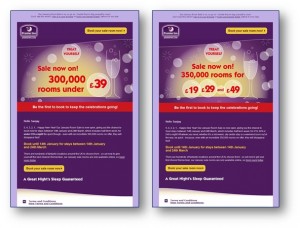Triple pricepoints & managing expectations of price
Whitbread’s Premier Inn planning & promoting pricepoints
The brief
Whitbread is a large UK hospitality business with major lines of business in coffee shops with Costa Coffee, in hotels with Premier Inn and in restaurants with Beefeater, Table-Table & Brewers Fayre restaurant brands. Premier Inn is the UK’s largest hotel brand with over 650 sites throughout the country.
As a budget hotel brand, Premier Inn’s pricing is low with consistently effective promotional activity driving visits and booking online, to contribute to relatively high occupancy in the UK hotel sector. Whitbread had become used to promoting Premier Inn through heavy discounting for advance bookings, using pricepoints as low as just GBP £19 an overnight stay in a hotel room sleeping up to a family of four. Highest discounts were offered during Sale promotions which drove high traffic to web but with low conversion, with many customers complaining that the available inventory of low priced rooms was disappointingly low.
consistently effective promotional activity driving visits and booking online, to contribute to relatively high occupancy in the UK hotel sector. Whitbread had become used to promoting Premier Inn through heavy discounting for advance bookings, using pricepoints as low as just GBP £19 an overnight stay in a hotel room sleeping up to a family of four. Highest discounts were offered during Sale promotions which drove high traffic to web but with low conversion, with many customers complaining that the available inventory of low priced rooms was disappointingly low.
Could we find a way to drive up conversion and grow revenue? How could the brand stop disappointing customers? And could we start to wean the business off discounting to improve average room rate or revenue per room (ARR) and thereby revenue per available room (RevPAR)?
Strategy
We concluded that the very effective Sale promotions were good at bringing visitors to the website wanting to book, but web visitors expected to find cheap rooms everywhere at any time.
We felt sure that by managing customer expectations better, we could drive up conversion at a higher average spend. So the strategy proposal was to test promoting several pricepoints, not just one, presenting three prices together as ‘low-middle-high’.
Actions
We tested two new treatments against the original heavily discounted price promotion.  The two new treatments reassured customers of the scale of room inventory available to buy. The third treatment showed three prices together which gave customers a range of prices to expect if they chose to consider booking, rather than just the bargain basement deep discount pricepoint.
The two new treatments reassured customers of the scale of room inventory available to buy. The third treatment showed three prices together which gave customers a range of prices to expect if they chose to consider booking, rather than just the bargain basement deep discount pricepoint.
The big difference
The ‘control’ version applying the old, deep discounted pricepoint delivered the most bookings, but at the lowest average booking value. The new test versions returned different results, with ‘300,000 at £39’ lowest for bookings and revenue but with an average booking value above that of the control.
The clear winner was ‘350,000 at £19, £29 and £49’ because it returned marginally fewer bookings, but with an average booking value +18% above that of the control version. Plus the higher spend per booking carried through into total revenue of +14%. Triple pricepoints presented together, with both a low pricepoint and a high pricepoint acting as pricing anchors to manage the expectations of respondents more effectively so that customers were just as inclined to book and buy, but primed to be ready to spend more. In the budget hotel sector with fixed costs and slim margins, average booking value growth of +18% goes straight to the bottom line.







